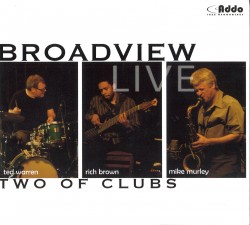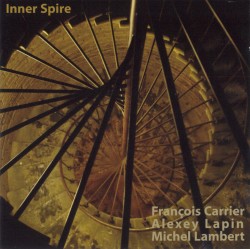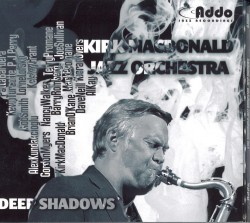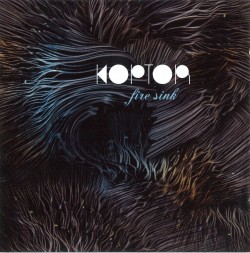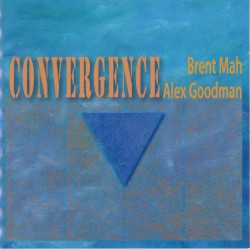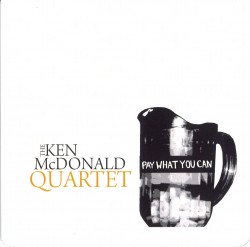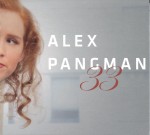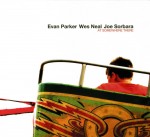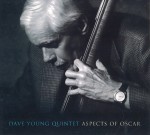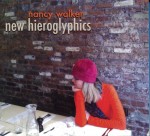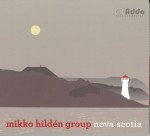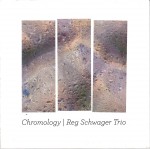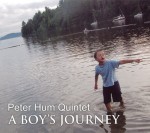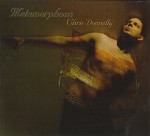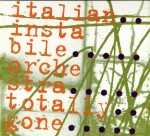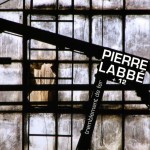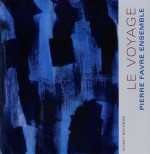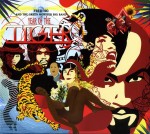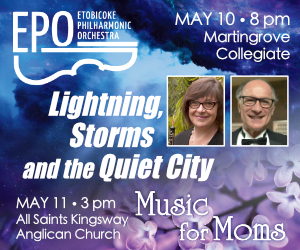Besides gaining a reputation for its demographically diverse and eminently liveable neighbourhoods, when it came to improvised music starting in the early 1970s Toronto was actually a world-class city in more than civic boosterism. That’s because on the initiative of photographer/musician Bill Smith, Sackville records was issuing LPs by some of the most significant avant-garde players from New York, Chicago and St. Louis. Recorded for the most part in local studios, these discs – and affiliated concerts – documented these emerging stylists and designated Toronto as part of the international free jazz firmament. Now Chicago’s Delmark label is distributing CD reissues of the original Sackville records.
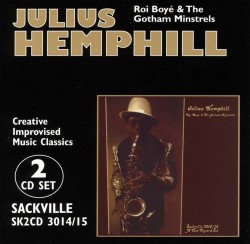 Probably the most significant session was the label’s one two-disc package, saxophonist and flautist Julius Hemphill’s Roi Boyé & the Gotham Minstrels (Sackville SKCD2-3014/15 www.delmark.com). It’s a solo session that’s a pioneering example of using multi-tracking to create a compelling audio drama. Best known as a founder of the World Saxophone Quartet (WSQ), Hemphill (1938-1995) was interested in programmatic story telling not reed bravado. One observation is that the often-delicate timbres of the reedist’s overdubbed flutes were showcased at a time when the cliché of advanced jazz imagined every player a discordant eardrum-assaulter. Even when playing astringent alto saxophone, as on the second track, Hemphill is so in control of his material that he doesn’t lapse into glottal punctuation. Instead he replicates a New York subway journey through an overdubbed choir of yelping saxophones. Exactly one year later, Hemphill and his WSQ colleague Oliver Lake recorded the duo disc, Buster Bee (Sackville SKCD2-3016 www.delmark.com) in Toronto. As notable as their teamwork was, it lacks the revolutionary force of the solo set. On “Roi Boyé” for instance, Hemphill devotes the final track to a narrative about a black artist’s life in a materialistic society, punctuating his story-telling with harsh squeals, discordant whorls and split tones. Another track replicates a butterfly’s attraction through stacked and harmonized reed tones that meander linearly; while a third is practically a capriccio, with the theme bouncing along, propelled by carefully stacked, overdubbed horn vamps, while reed-biting and pressurized vibratos from the alto saxophone come in-and-out of aural focus for contrast, ending with a distinctive contralto textural upturn. Hemphill doesn’t neglect jazz’s bedrock, the blues, either. One extended piece positions a soulful alto saxophone riff, basso lip-bubbling from the flute and a heavily breathed soprano saxophone line that could come from a country blues harmonica, while discordant pitches slide contrapuntally among them. Eventually the track reflects both the guttural despair and altissimo promise of the music.
Probably the most significant session was the label’s one two-disc package, saxophonist and flautist Julius Hemphill’s Roi Boyé & the Gotham Minstrels (Sackville SKCD2-3014/15 www.delmark.com). It’s a solo session that’s a pioneering example of using multi-tracking to create a compelling audio drama. Best known as a founder of the World Saxophone Quartet (WSQ), Hemphill (1938-1995) was interested in programmatic story telling not reed bravado. One observation is that the often-delicate timbres of the reedist’s overdubbed flutes were showcased at a time when the cliché of advanced jazz imagined every player a discordant eardrum-assaulter. Even when playing astringent alto saxophone, as on the second track, Hemphill is so in control of his material that he doesn’t lapse into glottal punctuation. Instead he replicates a New York subway journey through an overdubbed choir of yelping saxophones. Exactly one year later, Hemphill and his WSQ colleague Oliver Lake recorded the duo disc, Buster Bee (Sackville SKCD2-3016 www.delmark.com) in Toronto. As notable as their teamwork was, it lacks the revolutionary force of the solo set. On “Roi Boyé” for instance, Hemphill devotes the final track to a narrative about a black artist’s life in a materialistic society, punctuating his story-telling with harsh squeals, discordant whorls and split tones. Another track replicates a butterfly’s attraction through stacked and harmonized reed tones that meander linearly; while a third is practically a capriccio, with the theme bouncing along, propelled by carefully stacked, overdubbed horn vamps, while reed-biting and pressurized vibratos from the alto saxophone come in-and-out of aural focus for contrast, ending with a distinctive contralto textural upturn. Hemphill doesn’t neglect jazz’s bedrock, the blues, either. One extended piece positions a soulful alto saxophone riff, basso lip-bubbling from the flute and a heavily breathed soprano saxophone line that could come from a country blues harmonica, while discordant pitches slide contrapuntally among them. Eventually the track reflects both the guttural despair and altissimo promise of the music.
 Another pace-setting session took place a year earlier, with George Lewis’ The Solo Trombone Record (Sackville SKCD2-3012 www.delmark.com), the first session under his own name by the musician now as famous for his computer-directed music as for his brass mastery. Audacious to the nth degree, the disc’s Tonebursts is another example of overdubbing. But while Hemphill was 39, with years of gigging behind him when “Roi Boyé” was recorded, Lewis was all of 24. In spite of his youth, the 20-minute track is another tour-de-force with the trombonist evidentially able to stylistically replicate key attributes of older brassmen, calling upon the color of Tricky Sam Nanton, the sophistication of Lawrence Brown and the speed of J. J. Johnson at will and blending them as needed. Here expressive lines are sometimes replaced by a sudden staccato brays, or mid-improv, a trombone choir harmonizes, with its parts segmented among bass trombone pedal-point, alto trombone open-horn linearity, and the highest textures strained though a cup mute. There are even times during which you could swear a supple saxophone is soloing accompanied by phantom guitar strokes. Besides expressive glissandi, timbres are sourced from deep within the trombone body; capillary lines are lobbed from one ‘bone to another; or rubato tones share space with polyharmonies and polytones. Eventually techniques such as oscillated mouthpiece kisses are replaced with resonating runs that maintain an almost conventional jazz-styled line while at the same time making room for growling ostinatos and altissimo cries. Lewis also provides a solo interpretation of Lush Life, but more impressive are other tracks such as Untitled Dream Sequence. Taken at the same tempo as that Billy Strayhorn classic, the Dream Sequence’s note-slurping, double-tongued accents and speedy glisses from every part of the horn demonstrate that exciting improvisation doesn’t have to be fortissimo, super-fast or discordant.
Another pace-setting session took place a year earlier, with George Lewis’ The Solo Trombone Record (Sackville SKCD2-3012 www.delmark.com), the first session under his own name by the musician now as famous for his computer-directed music as for his brass mastery. Audacious to the nth degree, the disc’s Tonebursts is another example of overdubbing. But while Hemphill was 39, with years of gigging behind him when “Roi Boyé” was recorded, Lewis was all of 24. In spite of his youth, the 20-minute track is another tour-de-force with the trombonist evidentially able to stylistically replicate key attributes of older brassmen, calling upon the color of Tricky Sam Nanton, the sophistication of Lawrence Brown and the speed of J. J. Johnson at will and blending them as needed. Here expressive lines are sometimes replaced by a sudden staccato brays, or mid-improv, a trombone choir harmonizes, with its parts segmented among bass trombone pedal-point, alto trombone open-horn linearity, and the highest textures strained though a cup mute. There are even times during which you could swear a supple saxophone is soloing accompanied by phantom guitar strokes. Besides expressive glissandi, timbres are sourced from deep within the trombone body; capillary lines are lobbed from one ‘bone to another; or rubato tones share space with polyharmonies and polytones. Eventually techniques such as oscillated mouthpiece kisses are replaced with resonating runs that maintain an almost conventional jazz-styled line while at the same time making room for growling ostinatos and altissimo cries. Lewis also provides a solo interpretation of Lush Life, but more impressive are other tracks such as Untitled Dream Sequence. Taken at the same tempo as that Billy Strayhorn classic, the Dream Sequence’s note-slurping, double-tongued accents and speedy glisses from every part of the horn demonstrate that exciting improvisation doesn’t have to be fortissimo, super-fast or discordant.
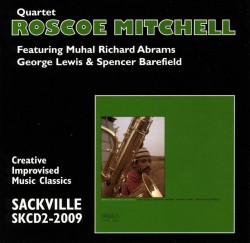 Lewis was also more than just present a year previously when saxophonist Roscoe Mitchell’s Quartet on Sackville (SKCD2-3009 www.delmark.com) was recorded live at Toronto’s long defunct A Space gallery. The momentous session not only captures a then-rare example of the Art Ensemble of Chicago’s saxophonist performing without the other band members, but puts him in an all-star context. Other quartet members are pianist Muhal Richard Abrams, probably the most respected Association for the Advancement of Creative Musicians founder, and Detroit guitarist Spencer Barefield. Mitchell and Lewis expose sonorous counterpoint on one duo track and the trombonist alone turns Mitchell’s Olobo into another brass tour-de-force, blending a near ballad exposition with guttural sniggers, near-silent breaths and a coda of overblowing. Group dynamics are memorable as well. Sonic tension is almost visible on Tnoona. With the theme built up from the saxophonist’s tongue flutters and split tones, guitar vibration, Lewis’ sliding plunger work and Abrams’ focussed note clusters, it finally dissolves without release. Aleatory as suggested by its title, Mitchell’s Cards is the CD’s most fully-realized composition. Chromatic forward motion is due to the pianist’s expressive low-frequency runs, but the linear form is punctuated by Barefield’s oscillating amp reverb. Meanwhile Mitchell’s reeds bark with clown-horn-like blasts and dilating split tones, as the trombonist contributes plunger grace notes and discursive pedal point. A coda of stentorian guitar strums completes the improvisation.
Lewis was also more than just present a year previously when saxophonist Roscoe Mitchell’s Quartet on Sackville (SKCD2-3009 www.delmark.com) was recorded live at Toronto’s long defunct A Space gallery. The momentous session not only captures a then-rare example of the Art Ensemble of Chicago’s saxophonist performing without the other band members, but puts him in an all-star context. Other quartet members are pianist Muhal Richard Abrams, probably the most respected Association for the Advancement of Creative Musicians founder, and Detroit guitarist Spencer Barefield. Mitchell and Lewis expose sonorous counterpoint on one duo track and the trombonist alone turns Mitchell’s Olobo into another brass tour-de-force, blending a near ballad exposition with guttural sniggers, near-silent breaths and a coda of overblowing. Group dynamics are memorable as well. Sonic tension is almost visible on Tnoona. With the theme built up from the saxophonist’s tongue flutters and split tones, guitar vibration, Lewis’ sliding plunger work and Abrams’ focussed note clusters, it finally dissolves without release. Aleatory as suggested by its title, Mitchell’s Cards is the CD’s most fully-realized composition. Chromatic forward motion is due to the pianist’s expressive low-frequency runs, but the linear form is punctuated by Barefield’s oscillating amp reverb. Meanwhile Mitchell’s reeds bark with clown-horn-like blasts and dilating split tones, as the trombonist contributes plunger grace notes and discursive pedal point. A coda of stentorian guitar strums completes the improvisation.
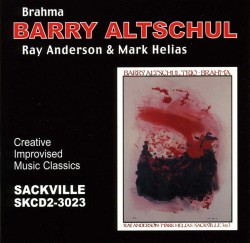 Other 1970s group sessions involve a rare excursion into focused European improvisations on All Kinds of Time (Sackville SKCD2-3010 www.delmark.com), by a duo of German pianist/vibist Karl Berger and British bassist Dave Holland, who now follows a more mainstream course; plus pianist Anthony Davis, best-known for operas such as X and Amistad, expressing himself with a suite and shorter composition backed by violin, cello and percussion. But it is Brahma (Sackville SKCD2-3023 www.delmark.com) from 1980 which best demonstrates the musical future which was partially ushered in by these earlier discs. Led by veteran drummer Barry Altschul, the unusually constituted trio introduced two players now in the prime of their career: trombonist Ray Anderson and bassist Mark Helias. Improvising jazz is never static, and unlike uncompromising abstraction that characterizes earlier discs in this set, swinging elements are now mixed with the risk-taking solos. These rhythmic components still go far beyond the conventional. Altschul’s solo on the 17-minute title track may hit a groove, but his bulls-eye beat is amplified with timbre scrambles using mallets and sticks, ratamacues and drags on toms and snares, plus numerous interjections that bring in cymbal shaking, bell-tree resonation, waterphone scrapes, cow bell thwacks and shrills from slide whistles. The finale involves shaking a thunder sheet for fortissimo oscillations; the mid-section is based on a martial beat from the percussionist and wide-angled stops and thumps from Helias. Overall, this drum finesse is synchronized with elephant-like grunts from Anderson’s sousaphone when the brassman isn’t altering themes with flutter-tonguing, freak note whinnying and gutbucket slurs. Capable of smooth balladry on Altschul’s mid-tempo Irina, Anderson also whistles and slurs his way through his own Spanish-tinged Con Alma de Noche backed by woodblock bops and opposite sticking from the drummer. And he enlivens the bassist’s Lism with triplet-extended brassiness, allowing Helias to hand pump and sluice his way up-and-down the strings with guitar-like expressiveness as the stop-time tune evolves.
Other 1970s group sessions involve a rare excursion into focused European improvisations on All Kinds of Time (Sackville SKCD2-3010 www.delmark.com), by a duo of German pianist/vibist Karl Berger and British bassist Dave Holland, who now follows a more mainstream course; plus pianist Anthony Davis, best-known for operas such as X and Amistad, expressing himself with a suite and shorter composition backed by violin, cello and percussion. But it is Brahma (Sackville SKCD2-3023 www.delmark.com) from 1980 which best demonstrates the musical future which was partially ushered in by these earlier discs. Led by veteran drummer Barry Altschul, the unusually constituted trio introduced two players now in the prime of their career: trombonist Ray Anderson and bassist Mark Helias. Improvising jazz is never static, and unlike uncompromising abstraction that characterizes earlier discs in this set, swinging elements are now mixed with the risk-taking solos. These rhythmic components still go far beyond the conventional. Altschul’s solo on the 17-minute title track may hit a groove, but his bulls-eye beat is amplified with timbre scrambles using mallets and sticks, ratamacues and drags on toms and snares, plus numerous interjections that bring in cymbal shaking, bell-tree resonation, waterphone scrapes, cow bell thwacks and shrills from slide whistles. The finale involves shaking a thunder sheet for fortissimo oscillations; the mid-section is based on a martial beat from the percussionist and wide-angled stops and thumps from Helias. Overall, this drum finesse is synchronized with elephant-like grunts from Anderson’s sousaphone when the brassman isn’t altering themes with flutter-tonguing, freak note whinnying and gutbucket slurs. Capable of smooth balladry on Altschul’s mid-tempo Irina, Anderson also whistles and slurs his way through his own Spanish-tinged Con Alma de Noche backed by woodblock bops and opposite sticking from the drummer. And he enlivens the bassist’s Lism with triplet-extended brassiness, allowing Helias to hand pump and sluice his way up-and-down the strings with guitar-like expressiveness as the stop-time tune evolves.
Advanced improvisations featuring out-of-towners, not to mention the burgeoning local free music community, continue to be recorded in the GTA. These historically important and musically impressive albums show how one series of discs successfully captured musical changes.
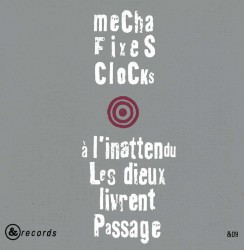 à l’inattendu les dieux livrent passage
à l’inattendu les dieux livrent passage

